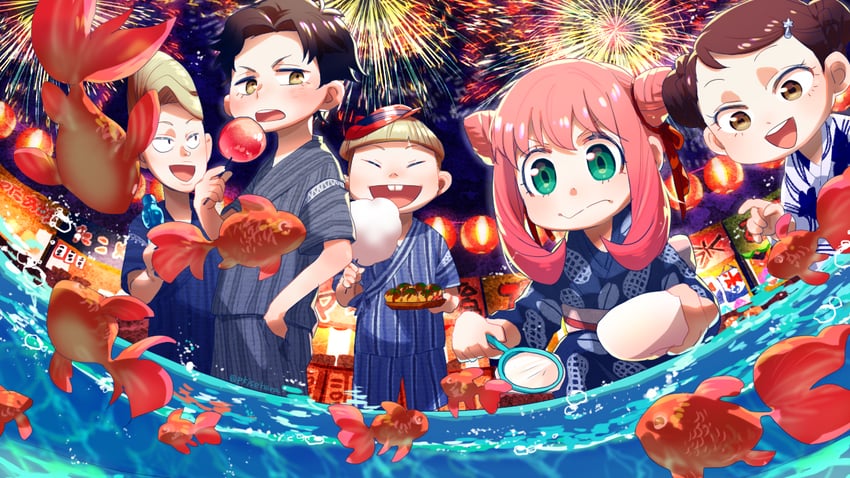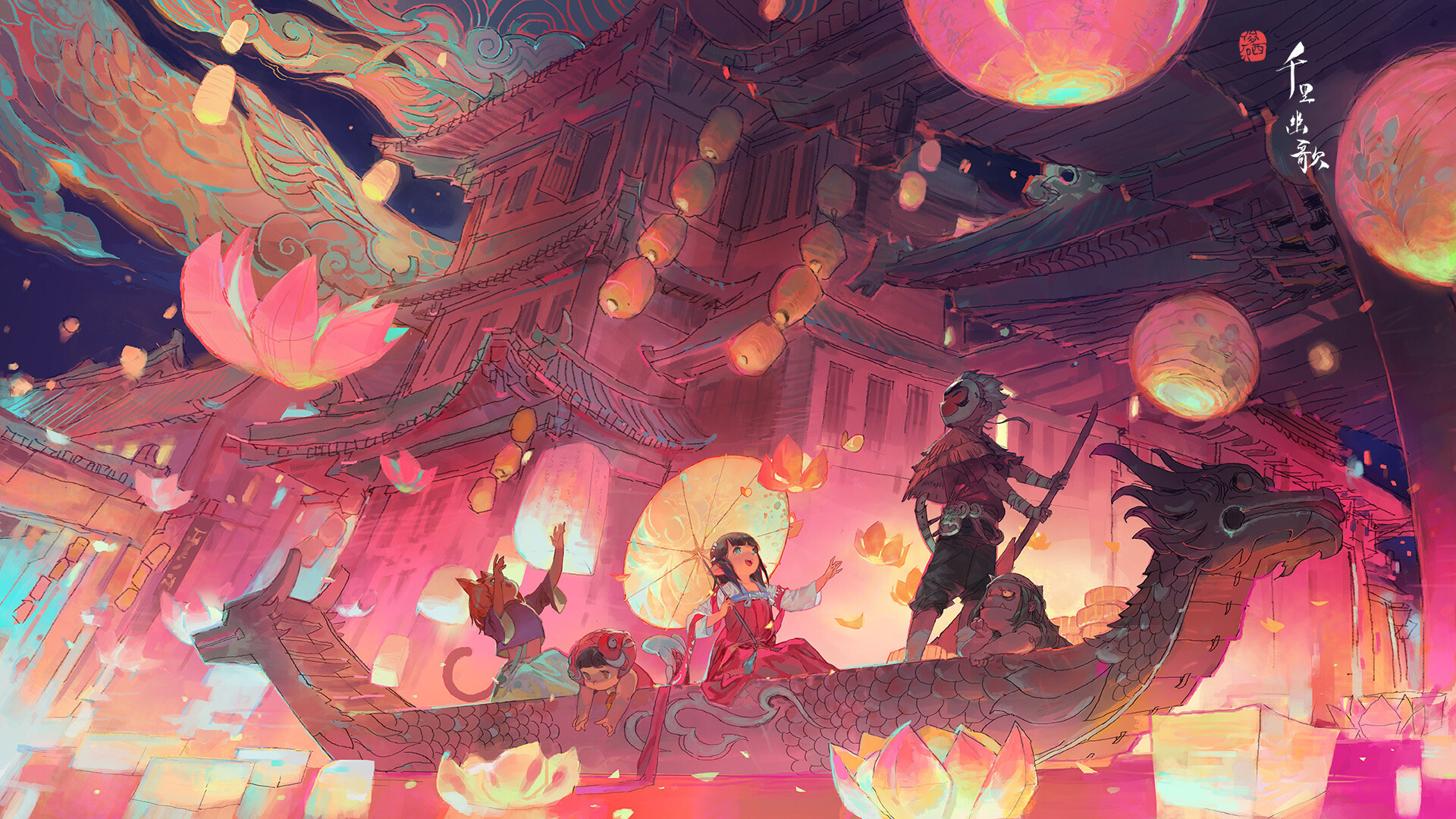Bonchi no Kuni LoreFeb 1, 2024 6:09:48 GMT -5
groupWaterfall Shinobi
age 18 years old
birthday 2/14
rank Sp. Jōnin
occupation Taki Lady
Oborozuki Arano likes this
Bonchi no kuni - Lore: matsuri A look at traditions, festivals and legends Basic Information Bonchi no Kuni, a small country nestled amidst lush landscapes, is home to diverse traditions influenced by neighboring nations. The inhabitants revere nature and its dangers, celebrating the healing properties of medicinal plants and the rhythmic rainfall that sustains the vibrant ecosystem. Waterfalls hold sacred significance, and the perpetual summer-like climate shapes their way of life. With a blend of old and new practices, Bonchi no Kuni embraces the unity of cultures while cherishing its unique traditions, creating a harmonious balance between human existence and the untamed wilderness. Celebrating spring - mizu haru matsuri [water spring festival]  People celebrate the arrival of spring with great fervor and joy during the Mizu Haru Matsuri, also known as the Water Spring Festival. This festival blends the rich cultural heritage of Bonchi no Kuni with the renewal and rebirth that come with the changing of seasons. The festival serves as a bridge between the people and the natural world, emphasizing harmony, gratitude, and the interconnectedness of all living beings. One week leading up to Mizu Haru Matsuri, the entire community comes together to prepare for the festivities. The streets and houses are adorned with vibrant spring flowers, colorful banners, and intricate water-themed decorations. The air is filled with the scent of flower blossoms, and the cities, towns, and villages are bustling with excitement. The festival begins seven days later with an enchanting opening ceremony at sunrise. The festival participants gather near a nearby sacred waterfall, believed to be the source of life and abundance in Bonchi no Kuni. The community's elders offer prayers of gratitude to the water spirits, expressing thanks for the life-giving properties of water and the blessings it brings. This is followed by a traditional dance performance by local artists, showcasing graceful movements that imitate the flow of water. A highlight of Mizu Haru Matsuri is the symbolic waterfall blessing. Festival participants gather near waterfalls, dressed in traditional attires. Each person carries a small vessel filled with water from their home, representing the unity of the community and their connection to nature. As a symbol of renewal, they pour their vessels into the waterfalls, releasing their worries and receiving blessings for the coming year. Throughout the festival, vibrant music and dance performances fill the air. Local musicians play traditional instruments, such as the shamisen and taiko drums, creating a rhythmic and festive atmosphere. Colorfully dressed dancers perform traditional Bonchi no Kuni dances, their movements reflecting the grace and beauty of nature. Bonchi no Kuni's reverence for medicinal plants is celebrated in a vibrant bazaar where herbalists and healers from the surrounding villages and towns gather. They showcase a wide array of herbs, flowers, and natural remedies, sharing their knowledge and wisdom with festival attendees. Visitors can learn about the healing properties of different plants, receive herbal consultations, and even purchase traditional remedies. Mizu Haru Matsuri also features various traditional games and contests that bring the communities together in playful competition. These include archery competitions, kite flying, tug-of-war, and boat races on the nearby rivers. The games symbolize the harmony between humans and nature, fostering a sense of camaraderie and joy among the participants. Food holds a special place in Bonchi no Kuni's culture, and the festival offers a gastronomic feast for the senses. Local vendors set up stalls, offering an abundance of traditional dishes prepared with seasonal ingredients. Visitors can savor delicacies like grilled river fish, fragrant rice dishes, and refreshing herbal teas. As the sun sets and darkness blankets cities, towns, and villages the festival culminates in a mesmerizing lantern parade. Participants carry beautifully crafted lanterns, depicting scenes from nature and mythical creatures. The soft glow of the lanterns illuminates the streets, creating a magical ambiance. The parade usually concludes at the central squares, where a grand bonfire is lit, symbolizing the collective spirit of Bonchi no Kuni. Mizu Haru Matsuri celebrates the unique cultural tapestry of Bonchi no Kuni while embracing the rejuvenation and hope that spring brings. Through this festival, the people of Bonchi no Kuni express their deep connection with nature and their commitment to preserving the delicate balance between human existence and the untamed wilderness that surrounds them. Celebrating winter - hikari matsuri [the festival of lights]  The winter season brings a unique and enchanting celebration known as Hikari Matsuri, the Festival of Lights. Hikari Matsuri combines reverence for nature with the mesmerizing beauty of lights, creating a magical experience for all who participate. The Hikari Matsuri occurs during the nighttime of the winter solstice, which marks the year's shortest day and a time of prevailing darkness. Taught preparations start a week or two before. This vibrant celebration is hosted at the core of Bonchi no Kuni, nestled amidst a vast forest clearing adjacent to a magnificent waterfall that holds great reverence in the nation's legends. For those unable to partake in the primary festival, there is no need for concern, as numerous comparable festivities are organized throughout the country, spanning cities, towns, and villages alike. As dusk settles, the festivities commence with the lighting of hundreds of lanterns. These lanterns, crafted from biodegradable materials and adorned with vibrant colors, are gently placed upon small wooden boats. Each boat carries a small offering made from local flowers, leaves, and fragrant herbs, symbolizing gratitude for nature's abundance and wishes for the coming year. The boats are then released onto the serene surface of the waterfall pool, creating a breathtaking display of floating lights that dance with the cascading water. The festival grounds are illuminated with a network of pathways lined with candles, casting a warm and inviting glow throughout the forest. These candlelit pathways symbolize the unity and interconnectedness of the Bonchi no Kuni community. Visitors can stroll along these paths, basking in the ethereal atmosphere and embracing the tranquility of the winter night. In homage to the natural wonders of Bonchi no Kuni, firefly-inspired performances take place on a specially constructed stage. Dancers adorned with illuminated costumes mimic the graceful movements and twinkling lights of fireflies, weaving their way through the darkness. Their performances are accompanied by traditional music and rhythmic melodies, captivating the audience and evoking a sense of wonder and enchantment. Alongside the festival grounds, a bustling winter market comes to life, featuring local artisans and craftsmen showcasing their creations. Visitors can explore a wide array of handmade goods, including traditional winter clothing, intricately woven baskets, unique pottery, and aromatic herbs and spices. The market is a celebration of the community's talent and craftsmanship, providing an opportunity to support local businesses while immersing oneself in the cultural richness of Bonchi no Kuni. To warm the spirits and bring a cozy touch to the winter celebration, a large bonfire is lit in the center of the festival grounds. People gather around the crackling flames, sharing stories, laughter, and delicious traditional winter treats. The bonfire acts as a beacon of warmth and camaraderie, reminding everyone of the resilience of the community and their connection to nature even during the coldest months. Through Hikari Matsuri, Bonchi no Kuni embraces the winter season and celebrates the beauty of light, nature, and community. The festival encapsulates the essence of the country's traditions, fostering a deep appreciation for the untamed wilderness and the unity of cultures that make Bonchi no Kuni a truly extraordinary place. *Permission to repost for ease of updating/editing by Yofie. |
Necronomicon_Nightmare
has written 768 posts









































